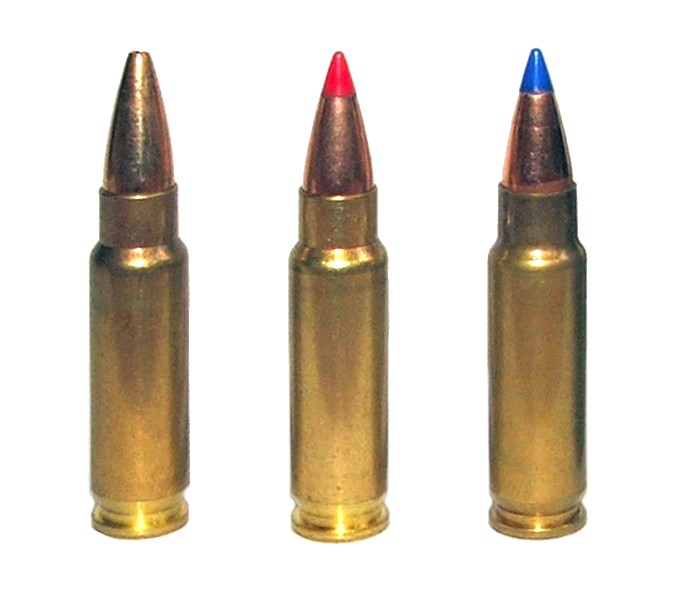Pistol rounds are easy to pick out of a crowd, aren’t they? Pistol rounds are short and boring. It doesn’t really get interesting until you start looking at some of the wild self-defense rounds. Rifle rounds, on the other hand, are long and pointy with cool bullets that have colored polymer tips. (The guys and gals from the outdoor range are rolling their eyes now.) You may laugh, but that’s really your basic pistol shooter’s understanding of cartridges. If it’s not your view, then you’re not basic, right?
A quick look at pistol cartridges reveals they are all look pretty much the same except for the .357 SIG. It was developed in the mid 90’s from a .40 caliber cartridge that was necked down to fit the 9mm bullet. The .357 Magnum has a rim and goes in a revolver. The .357 SIG has the same power but fits in a semi-automatic. So the .357 SIG sticks out in a crowd of pistol rounds because the case has shoulders.
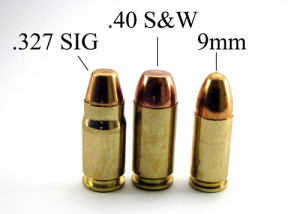
Imagine the questions from the new shooters when they see these rounds being loaded into a handgun!
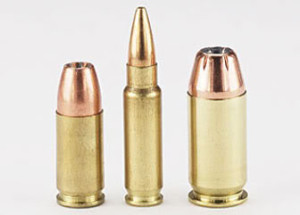
The round on the left is a 9mm. The round on the right is a .40 caliber. But WHAT is that rifle bullet doing with them??
Welcome to the Five-seveN® round. It was developed by FN Herstal (FN) at the request of NATO to replace the 5.56mm NATO round. The odd capitalization is trademarked and intended to highlight the manufacturer (FN). Like the .357 SIG, it has shoulders. It’s pretty tiny though. The 5.56mm NATO round is roughly the same size as a .223 caliber bullet. The FN 5.7mm is .224 caliber.
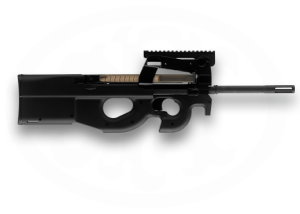
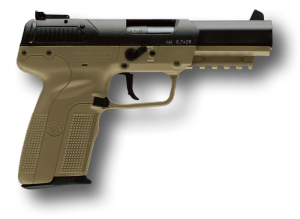
FN created the very odd looking PS-90 bullpup rifle in response to the NATO request in the late 1980’s and developed the Five-seveN pistol as a companion firearm, both using the 5.7mm cartridge.
The 5.7mm has ballistic performance similar to a .22 Magnum. When the 5.7mm round is fired from the pistol-length barrel of the Five-seveN, the speeds are 1,800 fps or less. If the round is fired from the longer barrel of the PS-90, it tops out at about 2,130 fps.
FN originally restricted the 5.7mm round to military and law enforcement, but opened it to civilian shooters in 2004. There are basically two rounds available to civilians that you can shoot at most indoor pistol ranges, the lead-free hollow-point, and the sporting rounds. (The sub-sonic round is fine, but unavailable to civilians.)
The armor-piercing and the tracer rounds, when fired from the pistol move way too fast for most indoor pistol ranges.
All the 5.7mm rounds are now lead-free. The hollow point, training round and sporting rounds are easy to identify. The training round has a green bullet tip. The sporting rounds have red or blue colored polycarbonate tips. The common sporting rounds have a muzzle velocity of 1650 fps when fired from the Five-seveN pistol. The hollow point is a bit faster at 1890 fps. The sub-sonic rounds have a painted white bullet and only hit 985 fps.
If you’re shooting the 5.7mm and you get your hands on some bullets with a black tip, they will clock in at 2,130 fps even from the handgun. These are the armor piercing rounds. Sale is restricted. Same deal with the tracer rounds, which have a red painted bullet. (You can tell the sporting round from the tracer. The sporting round has what looks like a plastic tip on the bullet, while the tracer is painted metal.)
I’m a big fan of pistol-caliber carbines. I converted my Israeli Tavor from 5.56 to 9mm and I shoot both it and my .45 Long Colt Henry rifle at indoor pistol ranges all the time. However, even though the PS-90 is technically shooting a pistol cartridge, the round is too hot for your average indoor pistol range.
So if you see someone shooting a center-fire pistol with what appears to be a rifle cartridge, ask to take a closer look at that FN 5.7mm cartridge.
See you at the range and Happy New Year!
JoeGLOCK
